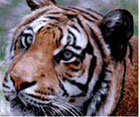
The Elusive Bengal Tiger 2004
Distributed by Chip Taylor Communications, 2 East View Drive, Derry, NH 03038-4812; 800-876-CHIP (2447)
Produced by Stuart Beecroft and Satoshi Okabe
Directed by Muriel Jackson
DVD-R, color, 30 min.
Jr. High - Adult
Animal Behavior, Environmental Studies, Religious Studies, Area Studies
Date Entered: 05/16/2006
Reviewed by Pamela Rose, Health Sciences Library, University at Buffalo, State University of New York“In the effort to stave off the extinction of yet another precious and irreplaceable species, are 4000 tigers enough?” -- Narrator Fred NapoliCharismatic mega-fauna like the tiger help to inspire support for saving species from extinction through footage that connects viewers with the magnificent presence and beauty of the animal. It is unusual, however, for the audience to enjoy a true vicarious experience, one in which they feel they are working side by side with the researchers -- knowing what they know and seeing what they see.
This film delivers that sympathetic experience as it traces the quest of photographer Masahiro Ajima to find the now grown Bengal tiger cub, known locally as Sita, whom he filmed seven years before in Bandhuvgarh National Park (600km SE of Delhi) in central India. His emotional attachment to Sita connects the viewer to his experience.
The journey begins in Delhi, where the indigenous setting of India -- its people, religions, and relationship to the Bengal tiger – is detailed before meeting the majestic beast. Hinduism in particular reflects a close relationship between tiger and human; tigers are close companions to several gods, including lord Shiva and the goddess Durga, “powerful rider of the tiger.” The biodiverse ecosystem of this tropical habitat is introduced through quick glimpses of some of the prey and other animals who share the park: elephants, golden jackals, hawks, tickbirds, sombres (very large deer, bigger than a cow), rhesus monkeys, Himalayan languors, and ant-eating sloth bears.
As the party searches for and finally finds the now adult Sita, they meet other tigers along the way. Each tiger encounter serves as a vehicle for delivering basic information “just in time” rather than as a tedious lecture-style monologue, connecting the viewer instantly to the real-time example.
Our first tiger encounter is with Charging Tiger, an aggressive male. As footage of his interaction with the group rolls, the narrator talks about behavior, size, weight, coloring, and body language while replaying and pausing certain frames to reinforce the information. Any resemblance to the benign domestic house cat is quickly dispelled as the animal lives up to his name and charges the elephant providing transport. Signs of tiger activity, including “feline blazing” (centimeter deep clawing of a tree trunk to establish territorial boundaries) and Sita’s distinctive tracks (extra long claw on 2nd toe of front paw) are noted.
As Sita is finally spotted walking through the underbrush, the narrator discusses their camouflage coloring -- black stripes against a tawny orange background allow tigers to blend in, seemingly disappearing in the brush. Sita and another tiger, Bagura, are identified by the black stripe pattern around the eyes and cheeks. These markings are as individual as fingerprints, creating an indelible way of identifying individuals, as we see in the still close-ups.
Details of tiger activity accompany footage of Sita as she goes about her daily routine. Sita has “clearly succeeded at the main task of being a tiger: hunting and killing prey.” The tiger’s stealth, hunting style, forceful muscle power, anatomy, diet, physiology, litter size, mortality and development, parenting, and habits are discussed as we watch Sita successfully hunt and care for her cubs. The sobering competition among animals for territory is evident as we watch while Charging Tiger forces Sita and her cubs to find a new territory.
Interspersed among the last half of the film are data on the park, numbers on the decline and subsequent protection and growth of tiger populations (from 6 in 1968 to over 4000 today), and the ecosystem required to support a stable population. Still photos of the ruthless hunting that took place during the period of the British Raj contrasts with later conservation efforts begun in 1970. Under the leadership of Indira Gandhi, Project Tiger was initiated in India to ban hunting and sales of tiger parts, and conservation efforts in other nations soon followed.
Despite their protection, human pressure and settlements right up to border of the park mean the inevitable loss of domestic animals and the occasional human attack by hungry tigers that don’t recognize stone walls as boundaries. Although humans continue to push species like the Bengal tiger to the brink of extinction, programs like Project Tiger and entreaties by world leaders such as the Dalai Lama, who earlier this year appealed to his followers to outlaw the animal skin trade in hopes of deterring tiger poaching, offer some hope. Films like this one also further the cause by increasing the public’s understanding of the animal and the issue.
The camera work and sound are excellent, and the editing is beautifully crafted to form a seamless flow of sight, sound, and information.
Highly recommended for junior high, high school, college, university and public library collections. Particularly useful for zoo research, ecological studies, conservation, and diversity studies collections.
There are a number of films about the “elusive Bengal tiger”. National Geographic has produced two of note: Land of the Tiger in 1985, which received lukewarm reviews, and the more successful and beautifully filmed The Hidden World of the Bengal Tiger, which follows a tigress for 2 years as she struggles to raise her cubs and survive. The National Wildlife Federation offers India: Kingdom of the Tiger released in IMAX format in 2002 and now available digitally mastered on DVD. However, this somewhat criticized film is more about Jim Corbett, an early 1900s writer, hunter and conservationist who became famous in India as both a hunter of man-eating tigers and later as a protector of Indian wildlife.